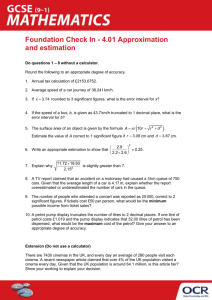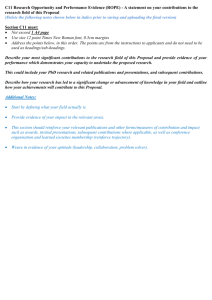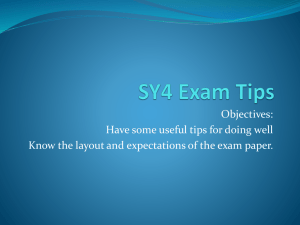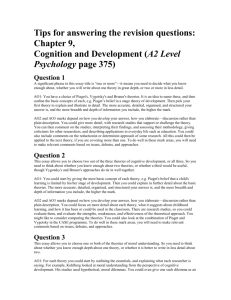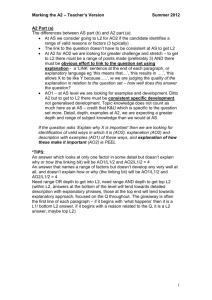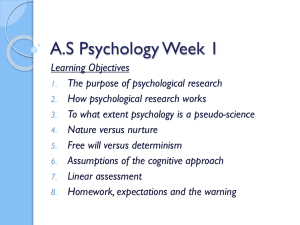Higher Check In - 4.01 Approximation and estimation
advertisement
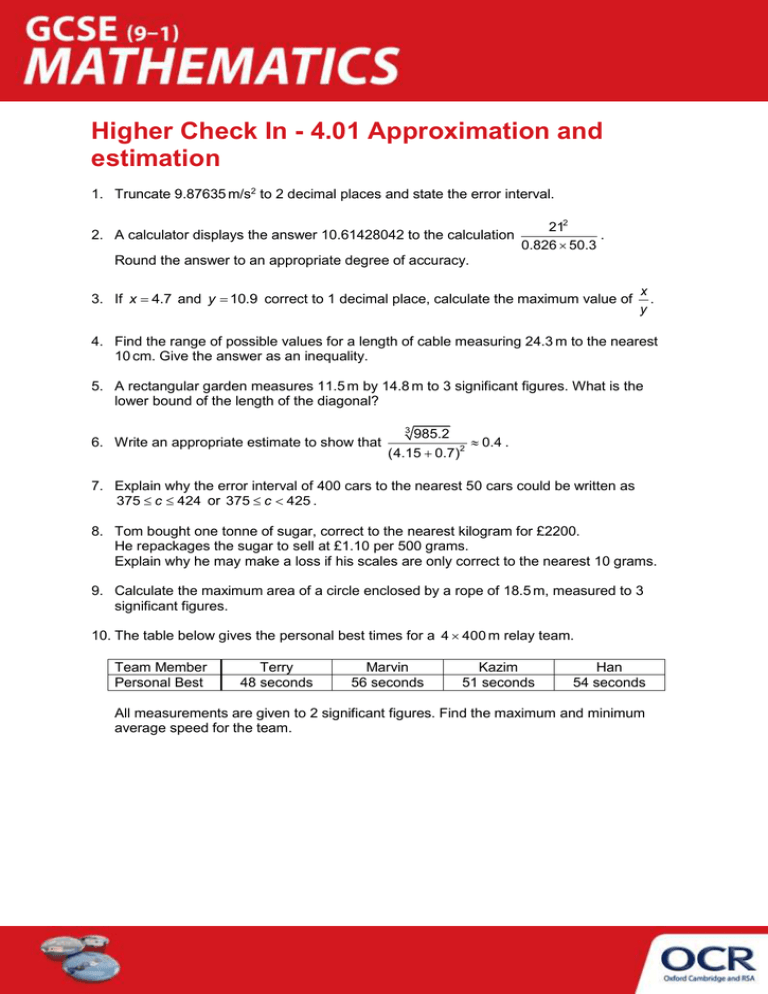
Higher Check In - 4.01 Approximation and estimation 1. Truncate 9.87635 m/s2 to 2 decimal places and state the error interval. 2. A calculator displays the answer 10.61428042 to the calculation 212 . 0.826 50.3 Round the answer to an appropriate degree of accuracy. 3. If x 4.7 and y 10.9 correct to 1 decimal place, calculate the maximum value of x . y 4. Find the range of possible values for a length of cable measuring 24.3 m to the nearest 10 cm. Give the answer as an inequality. 5. A rectangular garden measures 11.5 m by 14.8 m to 3 significant figures. What is the lower bound of the length of the diagonal? 3 6. Write an appropriate estimate to show that 985.2 0.4 . (4.15 0.7)2 7. Explain why the error interval of 400 cars to the nearest 50 cars could be written as 375 c 424 or 375 c 425 . 8. Tom bought one tonne of sugar, correct to the nearest kilogram for £2200. He repackages the sugar to sell at £1.10 per 500 grams. Explain why he may make a loss if his scales are only correct to the nearest 10 grams. 9. Calculate the maximum area of a circle enclosed by a rope of 18.5 m, measured to 3 significant figures. 10. The table below gives the personal best times for a 4 400 m relay team. Team Member Personal Best Terry 48 seconds Marvin 56 seconds Kazim 51 seconds Han 54 seconds All measurements are given to 2 significant figures. Find the maximum and minimum average speed for the team. Extension (Do not use a calculator) A West End theatre group are performing a show twice a day, every day for the month of July at a local theatre. The theatre has the following range of seating price options: Afternoon show price Evening show price Stalls £37.50 £51.50 Dress Circle £28.50 £37.50 Upper Circle £19.50 £22.50 There are 27 rows of 32 seats in the dress circle. The dress circle has half the number of seats as the stalls and the upper circle has a third of the number of seats as the dress circle. A journalist from the local news interviewed the manager of the theatre. The manager was reported to say that the show had sold out in July and broken their £10 million box office record. Show your working to explain whether you agree or disagree with the manager. Answers 1. 9.87 m/s2, 9.87 x 9.88 2. 10.614 (3 dp) (Answer need be no more accurate than the original values in the calculation) 3. 0.438 (3 sf) 4. 24.25 x 24.35 5. 18.7 m 3 6. 1000 10 2 0.4 (4 1)2 25 5 7. Cars are discrete data so 424 is the maximum number of cars. However, there is no possible number the value can take between 424 and 425, so 425 is also appropriate. 8. 999500 1.1 £2177.13 which is less than £2200. 505 9. 27.4 m2 10. Maximum 7.83 m/s, minimum 7.49 m/s Extension No, I don’t agree with the manager as approximately £9 million of sales income would be generated. Dress Circle Stalls Upper Circle Total Number of Seats 30 × 30 = 900 900 × 2 = 1800 900 ÷ 3 = 300 Tickets Sold Per Day 900 × 70 = £63 000 2000 × 90 = £180 000 300 × 40 = £12 000 £255 000 or £270 000 Tickets Sold in July £300 000 × 30 = £9 000 000 We’d like to know your view on the resources we produce. By clicking on ‘Like’ or ‘Dislike’ you can help us to ensure that our resources work for you. When the email template pops up please add additional comments if you wish and then just click ‘Send’. Thank you. If you do not currently offer this OCR qualification but would like to do so, please complete the Expression of Interest Form which can be found here: www.ocr.org.uk/expression-of-interest OCR Resources: the small print OCR’s resources are provided to support the teaching of OCR specifications, but in no way constitute an endorsed teaching method that is required by the Board, and the decision to use them lies with the individual teacher. Whilst every effort is made to ensure the accuracy of the content, OCR cannot be held responsible for any errors or omissions within these resources. © OCR 2016 - This resource may be freely copied and distributed, as long as the OCR logo and this message remain intact and OCR is acknowledged as the originator of this work. OCR acknowledges the use of the following content: n/a Please get in touch if you want to discuss the accessibility of resources we offer to support delivery of our qualifications: resources.feedback@ocr.org.uk Assessment Objective Qu. Topic R A G Assessment Objective Qu. Topic AO1 1 Use inequality notation to write the error interval of a truncated value AO1 1 Use inequality notation to write the error interval of a truncated value AO1 2 Round to an appropriate degree of accuracy AO1 2 Round to an appropriate degree of accuracy AO1 3 AO1 3 AO1 4 AO1 4 AO1 5 AO1 5 AO2 6 AO2 6 AO2 7 AO2 7 AO2 8 AO2 8 AO3 9 AO3 9 AO3 10 AO3 10 Assessment Objective Qu. Calculate upper bound of a calculation using measurements rounded to a known degree of accuracy Use inequality notation to write the error interval of a rounded value Calculate lower bound of a calculation using measurements rounded to a known degree of accuracy Use appropriate approximations to make an estimation of a complex calculation Understand the difference between error bounds for discrete and continuous quantities Use appropriate upper and lower bound values in a calculation set in a context Use appropriate upper bound values in calculations using geometric formulae Use appropriate upper and lower bound values in compound measure calculations Topic R A G Assessment Objective Qu. A G R A G Calculate upper bound of a calculation using measurements rounded to a known degree of accuracy Use inequality notation to write the error interval of a rounded value Calculate lower bound of a calculation using measurements rounded to a known degree of accuracy Use appropriate approximations to make an estimation of a complex calculation Understand the difference between error bounds for discrete and continuous quantities Use appropriate upper and lower bound values in a calculation set in a context Use appropriate upper bound values in calculations using geometric formulae Use appropriate upper and lower bound values in compound measure calculations Topic AO1 1 Use inequality notation to write the error interval of a truncated value AO1 1 Use inequality notation to write the error interval of a truncated value AO1 2 Round to an appropriate degree of accuracy AO1 2 Round to an appropriate degree of accuracy AO1 3 AO1 3 AO1 4 AO1 4 AO1 5 AO1 5 AO2 6 AO2 6 AO2 7 AO2 7 AO2 8 AO2 8 AO3 9 AO3 9 AO3 10 AO3 10 Calculate upper bound of a calculation using measurements rounded to a known degree of accuracy Use inequality notation to write the error interval of a rounded value Calculate lower bound of a calculation using measurements rounded to a known degree of accuracy Use appropriate approximations to make an estimation of a complex calculation Understand the difference between error bounds for discrete and continuous quantities Use appropriate upper and lower bound values in a calculation set in a context Use appropriate upper bound values in calculations using geometric formulae Use appropriate upper and lower bound values in compound measure calculations R Calculate upper bound of a calculation using measurements rounded to a known degree of accuracy Use inequality notation to write the error interval of a rounded value Calculate lower bound of a calculation using measurements rounded to a known degree of accuracy Use appropriate approximations to make an estimation of a complex calculation Understand the difference between error bounds for discrete and continuous quantities Use appropriate upper and lower bound values in a calculation set in a context Use appropriate upper bound values in calculations using geometric formulae Use appropriate upper and lower bound values in compound measure calculations
